10 Most Sustainable Lingerie Brands: The Conscious Consumer’s Guide
Impactful Ninja is reader-supported. When you buy through links on our site, we may earn an affiliate commission.
Learn more
Learn more
.
Hey fellow impactful ninja ? You may have noticed that Impactful Ninja is all about providing helpful information to make a positive impact on the world and society. And that we love to link back to where we found all the information for each of our posts. Most of these links are informational-based for you to check out their primary sources with one click. But some of these links are so-called "affiliate links" to products that we recommend. First and foremost, because we believe that they add value to you. For example, when we wrote a post about the environmental impact of long showers, we came across an EPA recommendation to use WaterSense showerheads. So we linked to where you can find them. Or, for many of our posts, we also link to our favorite books on that topic so that you can get a much more holistic overview than one single blog post could provide. And when there is an affiliate program for these products, we sign up for it. For example, as Amazon Associates, we earn from qualifying purchases. First, and most importantly, we still only recommend products that we believe add value for you. When you buy something through one of our affiliate links, we may earn a small commission - but at no additional costs to you. And when you buy something through a link that is not an affiliate link, we won’t receive any commission but we’ll still be happy to have helped you. When we find products that we believe add value to you and the seller has an affiliate program, we sign up for it. When you buy something through one of our affiliate links, we may earn a small commission (at no extra costs to you). And at this point in time, all money is reinvested in sharing the most helpful content with you. This includes all operating costs for running this site and the content creation itself. You may have noticed by the way Impactful Ninja is operated that money is not the driving factor behind it. It is a passion project of mine and I love to share helpful information with you to make a positive impact on the world and society. However, it's a project in that I invest a lot of time and also quite some money. Eventually, my dream is to one day turn this passion project into my full-time job and provide even more helpful information. But that's still a long time to go. Stay impactful,Affiliate Disclosure
Why do we add these product links?
What do these affiliate links mean for you?
What do these affiliate links mean for us?
What does this mean for me personally?
![]()
Amid growing concerns about the textile industry’s environmental impact, there is pressure to find greener clothes for your wardrobe, from the various clothes you wear out in public, to the more intimate pieces you may wear in private—such as lingerie. Unfortunately, fashion greenwashing makes it harder for you and all other consumers to figure out which clothing brands offer the most eco-friendly garments. So, we had to ask: Which are the most sustainable lingerie brands?
The most sustainable lingerie brands include Subset, Underprotection, and ColieCo, which use low-impact materials, minimize waste, and strive for textile circularity. In addition, The Very Good Bra and ColieCo commit to reducing their carbon footprints and manufacturing responsibly.
Whether you are searching for a full lingerie set or just a casual wireless bralette to add to your wardrobe without negatively impacting the soil, the water, the animals, and other people, there is a brand for you. So, let’s keep reading to learn more about the most sustainable lingerie brands and how they ensure sustainable, ethical practices.
Here’s How We Selected the Most Sustainable Lingerie Brands
Lingerie refers to pieces of clothing you wear closest to your skin and heart. Much is often desired from these small garments, from comfort to sensuality to support, on top of style and a feminine feel. Yet, there is one thing that definitely should not be missed: sustainability.
“Sustainable: The ability to be maintained at a certain rate or level | Avoidance of the depletion of natural resources in order to maintain an ecological balance”
Oxford Dictionary
The brands on this list were chosen based on their commitment and actions to promote sustainable practices while reducing the environmental impacts of the textile industry.
They are transparent about their materials, processes, and workforce management within their supply chain.
Some brands focus their efforts on reducing waste and optimizing natural resources while others strive to reduce the carbon footprint of their clothes.
All of these brands share the commitment to reshape the textile industry toward a more sustainable and Earth-friendly sector.
These Are the 10 Most Sustainable Lingerie Brands
Most Sustainable Lingerie Brands
Overall, these lingerie brands are sustainable. Yet, they take various approaches to reduce environmental impacts and uphold ethical standards. Let’s dive into each brand and find out more.
Subset: Carbon-Neutral Organic Cotton Underwear


“By seeking out the most environmentally responsible processes, low-impact fabrics and ethical manufacturing, we swap the greenwashing for integrity and accountability. ”
Subset
🌎
How do they ensure their sustainability?
Subset prioritizes sustainability by sourcing a high percentage of low-impact fabrics, offsetting carbon emissions, and facilitating underwear recycling. Firstly, they use GOTS-certified organic cotton, TENCEL™, recycled polyester, and regenerated and recycled nylon to reduce environmental impacts. For example, the Tank Bralette contains certified organic cotton (95% of the fabric), recycled nylon (83% of the straps), and TENCEL™ (69% of the band). Organic cotton, in particular, accounted for 92,1% of their fiber portfolio for 2022. Secondly, they reduce the impact of their carbon emissions with offsetting projects verified by Climate Neutral. For example, in 2022, they supported clean energy projects in India and Kenya. More importantly, they find ways to reduce their carbon footprint, such as using solar-powered energy in their supply chain and localized sourcing. Thirdly, in 2018, Subset launched the world’s first recycling program to save underwear, socks, bras, and tights from ending up in landfills. In 2022, they took back nearly 1 million of their own clothing items, as well as those of other brands.
🌐
How do they ensure their ethics?
Subset ensures their ethics by being transparent about their supply chain, all the way from farming to ginning, spinning, knitting, finishing, and packaging. Much of their supply chain is certified by Fairtrade International – Small Producers Organisations and Global Organic Textile Standard (GOTS). They ensure that workers at their suppliers are paid a living wage. Regarding the impact of their operation, Subset discloses on each product page the item’s impact, including not only carbon emission (which is offset) but also the reduction of water usage and synthetic pesticides thanks to their use of organic cotton.
🤝
Are they part of any giving-back programs?
Subset donates new, clean underwear to individuals and communities in need. In 2022, they donated over 2,260 items to organizations across the US, including Bronx Fire Relief, I Support the Girls, and Cultivate Initiatives. They also hold team volunteer days where their staff get together and work toward good causes, such as building an outdoor library.
🛍️
What is their product range?
- Best for: womenswear, menswear
- Product range: bras, panties, loungewear, maternity wear, plus-size
- Price range: $$$
- Size range: 2XS–4XL
Underprotection: Fashionable and Sustainable Lingerie

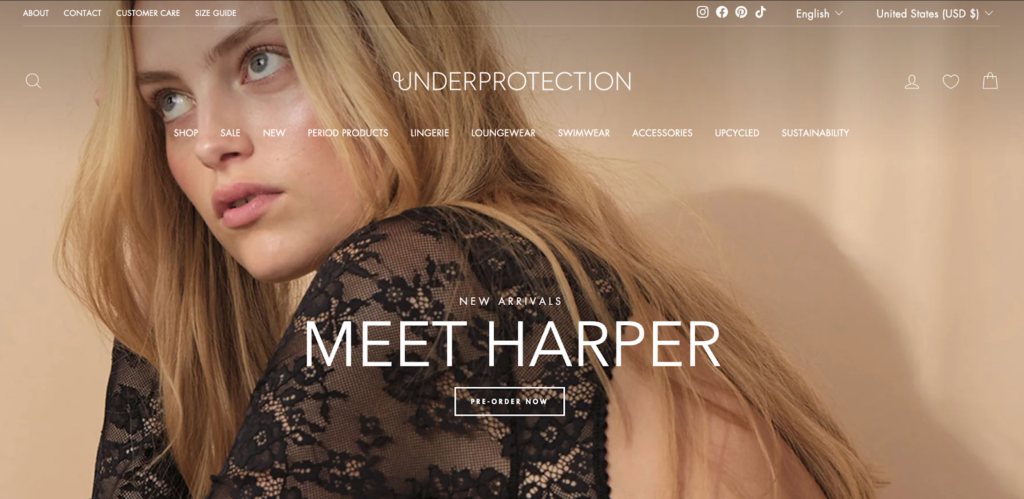
“We always strive to make the most sustainable choices even if it is not necessarily the most economically sensible choice, but for us, it is not only a business, it’s a lifestyle and a belief that the future must and can be greeners. It is our goal to always improve – in everything we do”
Stephan Rosenkilde, Co-Founder of Underprotection
🌎
How do they ensure their sustainability?
Underprotection ensures their sustainability by sourcing low-impact textile and packaging materials, prolonging their garments’ lifespan, and striving toward textile circularity. Firstly, they use a high proportion of eco-friendly fabrics, including TENCELTM Lyocell, organic cotton, recycled wool, and RWS-certified responsible sheep wool. All their synthetic fabrics come from recycled sources with the Global Recycle Standard certification, be it polyester, nylon, or elastane (spandex). On top of that, Underprotection also has fabrics made by utilizing by-product waste (banana leaves from the fruit industry and sour milk from the milk industry), helping to cut down waste and lower their environmental impacts. Regarding packaging materials, they opt for recycled or biodegradable materials. Secondly, the brand designs their products with quality and durability in mind to make them last, offers guaranteed repairs within the first two years, provides first-aid rewards for customers who fix up items themselves instead of replacing them, and equips consumers with detailed wash and care instructions for various types of fabrics. All these efforts aim to extend the lifespan of a garment and reduce its environmental cost. Thirdly, regarding their efforts toward textile circularity, they have a take-back program to give worn-out Underprotection pieces a second life, and an Upcycled collection that utilizes returned Underprotection products through their Take-back program, which covers leftover fabrics and discarded items. Last but not least, their main supplier uses solar-powered energy and harvests rainwater.
🌐
How do they ensure their ethics?
Underprotection ensures their ethics by holding a transparent and responsible supply chain. They bind their suppliers with a Code of Conduct, which covers all of the ILO’s Fundamental Principles and Rights at Work. Their suppliers have certifications that guarantee proper working conditions and a fair wage, including WRAP (Worldwide Responsible Accredited Production), Sedex, GOTS, and BSCI (Business Social Compliance Initiative). Underprotection also audits most of the final stage of production.
🤝
Are they part of any giving-back programs?
Underprotection partners with various organizations to give back to underprivileged communities and the Earth. For example, they plant a fixed 150 trees every month in their partnership with Treeapp. Another example is their partnership with the ReSea Project, an organization on a mission to end the ocean plastic crisis. Part of their sales go to support the cause.
🛍️
What is their product range?
- Best for: womenswear
- Product range: lingerie, loungewear, swimwear
- Price range: $$$
- Size range: XS–XL
The Very Good Bra: World’s First Compostable Bras

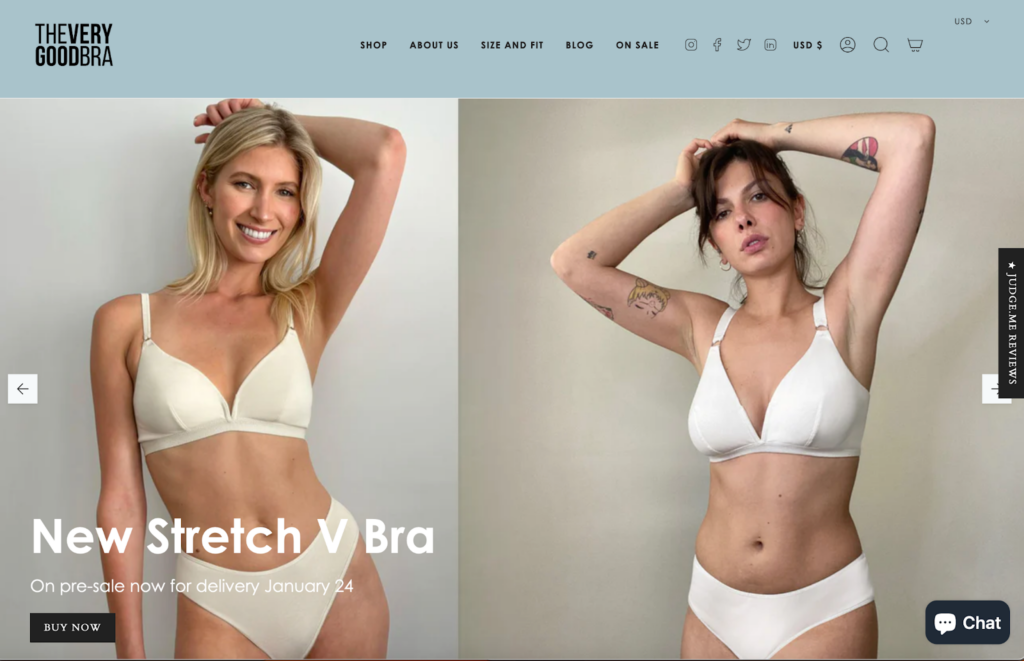
“Our materials are sourced worldwide to be 100% botanically circular, leaving no negative environmental impact at end of life. ”
The Very Good Bra
🌎
How do they ensure their sustainability?
The Very Good Bra ensures sustainability by prioritizing natural materials to make fully compostable bras, operating pre-sales to avoid overproduction, and facilitating services for repairing and reselling their items. Firstly, they exclusively use natural components for not only their base fabrics but also their sewing thread, labeling, and accessories so that their worn-out bras can be composted in your own garden. For example, the list of materials for the V for Victory Bra includes 100% organic cotton body fabric and liner fabric, as well as 100% plant-based thread and elastic from organic cotton and natural rubber. Additionally, The Very Good Bra packs their orders in recyclable tissue and a 100% compostable or 80% recycled and recyclable poly mailer. Secondly, they run at least three pre-sales a year with new styles, materials, or colors to plan their inventory more efficiently across their size range, minimizing waste. On top of that, they use all leftover fabric to manufacture small runs of sleepwear and briefs. Lastly, the brand offers replacement straps and runs a Facebook Buy Swap and Sell Group for bras needing new homes, extending the lifespan of each product and reducing its life-cycle’s environmental impact.
🌐
How do they ensure their ethics?
The Very Good Bra traces most of their supplier chain. They also have a Factory Code of Conduct, which covers four of the ILO’s Fundamental Principles and Rights at Work.
🤝
Are they part of any giving-back programs?
The brand works with a social enterprise to warehouse and fulfill orders, providing employment opportunities to people of all abilities who would otherwise struggle to find meaningful work. Through their partnership with i=Change, customers have the choice at checkout of three charities, to whom they can donate $1, post-sale. Additionally, The Very Good Bra has donated sample fabric to The Social Outfit, as well as to Whitehouse Design fashion students. They have also sent usable sample bras to The Uplift Project and Thread Together.
🛍️
What is their product range?
- Best for: womenswear
- Product range: bras, briefs, sleepwear, loungewear
- Price range: $$$
- Size range: S–XXL
ColieCo: Lingerie Made Sustainably With Deadstock, Recycled and Natural Fabrics
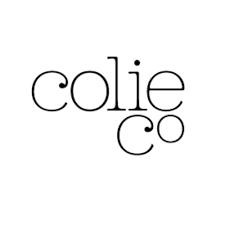
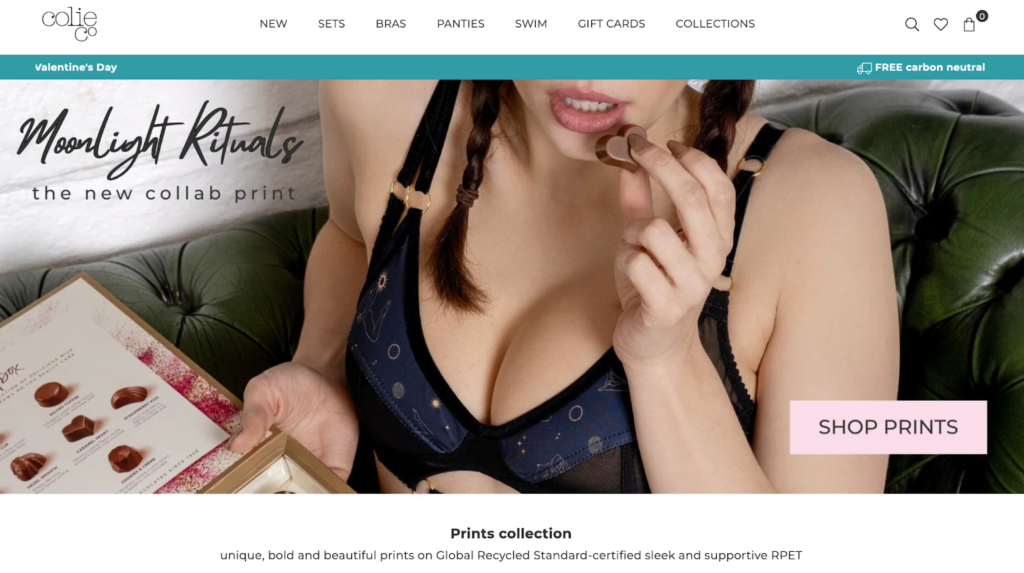
“We use only carefully-selected natural origin, recycled and reclaimed fabrics; manufacture to order and use intelligent garment design and cutting processes to minimise textile waste; and work with local suppliers to control our carbon footprint.”
ColieCo
🌎
How do they ensure their sustainability?
ColieCo ensures sustainability by sourcing low-impact fabrics and packaging materials, minimizing waste, and reducing carbon emissions. Firstly, they exclusively use fabrics in one of three categories: inherently sustainable natural fabrics, primarily recycled fabrics with OEKO-TEX® STANDARD 100 and Global Recycled Standard certifications, and fabrics reclaimed from fashion industry deadstock, line-ends, or offcuts. Specifically, reclaim fabrics—mesh and Lycra® made with nylon and elastane—account for the largest percentage of their fabric mix (60%). Additionally, ColieCo uses TENCELTM Lyocell and bamboo viscose, plant-based fabrics made in closed-loop systems. Regarding packaging, they exclusively use recycled paper and cardboard for supplies and lightweight, reusable, recycled-and-recyclable packaging for orders. All packaging is 100% plastic-free. Secondly, ColieCo’s approach to waste reduction includes a made-to-order operation, which reduces the waste ratio from 35% (industry average) to less than 10% of all materials. They also offer a free repair service to help customers get the best of their lingerie and swimwear while keeping textiles in circulation longer before going to landfills. Lastly, they reduce energy usage and carbon emissions by designing a studio where all ColieCo garments are manufactured, naturally and LED lit, naturally air-conditioned, and, like their office, powered by 100% renewable energy. They also work with Carbonfund.org to offset all of our shipping-related emissions, leaving the delivery of every ColieCo order carbon-neutral.
🌐
How do they ensure their ethics?
ColieCo holds their final manufacturing stage in-house in Sagres, Portugal, guaranteeing that all product construction and finishing workers are treated fairly, paid a full and fair living wage, and work in safe, comfortable, and discrimination-free conditions. They also trace most of their supply chain and uphold all suppliers with a Code of Ethics and Conduct that covers all of the ILO’s Fundamental Principles and Rights at Work.
🤝
Are they part of any giving-back programs?
ColieCo is not known to be part of any giving-back programs.
🛍️
What is their product range?
- Best for: womenswear
- Product range: lingerie sets, bras, panties, swimwear
- Price range: $$$
- Size range: 2XS–3XL
Anekdot: Uncycled Lingerie Made With Surplus Fabrics

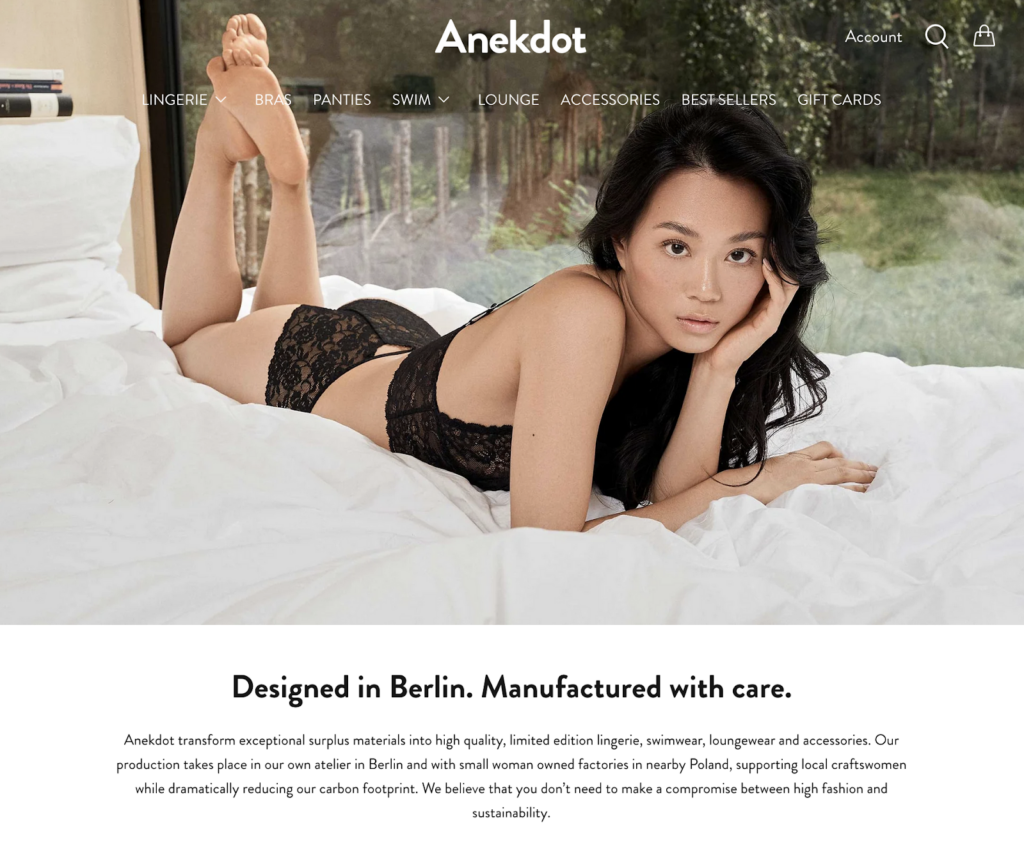
“We source our superb materials from production leftovers, end of lines, offcuts, deadstock and vintage trimmings turning them into something beautiful and meaningful for your everyday life.”
Anekdot
🌎
How do they ensure their sustainability?
Anekdot ensures their sustainability by upcycling textile materials, driving textile waste toward zero, and promoting slow, considerate fashion practices. They source materials for their apparel from production leftovers, end-of-lines, offcuts, deadstock, and vintage trimmings. For example, their Full Moon Longline Bralette is made with 90% upcycled nylon and 10% upcycled spandex, sourced from surplus in Italy. For the packaging, they recycled paper and compostable mailers that are carbon-negative, biodegradable, and partly made from corn starch. No plastics whatsoever! Secondly, Anekdot sources their materials first and designs later to maximize fabric use. They cut around small defects and create their patterns in a way that minimizes offcuts, striving for zero-waste production. Small textile scraps are used to make small accessories, special patchwork projects, and pilling for pillows. Lastly, they set an example of boycotting fast fashion by operating a made-to-order system, making their apparel seasonless, and using Black Friday to shed light on the consequences of short-lived impulse purchases and consumption from mass-producing, cheap fashion brands.
🌐
How do they ensure their ethics?
Anekdot visits their suppliers regularly. Their manufacturing partners are located in the EU, a low/medium-risk region for labor abuse.
🤝
Are they part of any giving-back programs?
Anekdot donates their textile surplus to art and education refugee projects at Tempelhof Airport and S27. During the Black Friday week of 2020, they donated 10% of sales to Drip by Drip to install bio-sand filters for communities in Bangladesh to access clean drinking water.
🛍️
What is their product range?
- Best for: womenswear
- Product range: swimwear, bra tops, underpants, loungewear, accessories
- Price range: $$$
- Size range: XS–XL
Araks: US-Made Intimate Garments

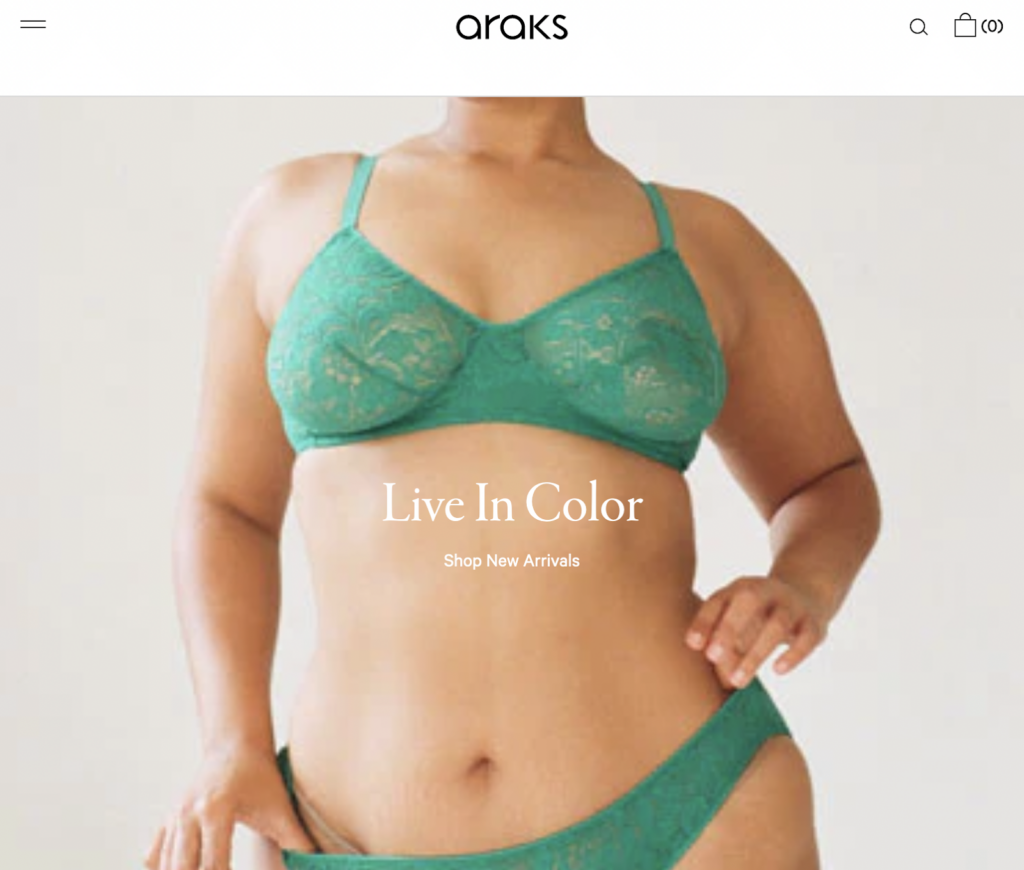
“Sustainability is a way of life for us and a journey of continuous improvement.”
Araks
🌎
How do they ensure their sustainability?
Araks’s sustainability incentives are guided by reducing, reusing, and recycling their products. They design their swimwear, loungewear, and lingerie around evergreen core fabrics, meaning that excess materials can be worked into future seasons instead of discarded. These include a medium proportion of low-impact materials, such as organic cotton with GOTS and OEKO-TEX® STANDARD 100 certifications, plant-dyed organic linen, ECONYL® (recycled nylon), and REFIBRA™ (closed-loop regenerated fibers using cotton waste). In particular, 50% of the fabrics used for swim collection are recycled nylon (instead of virgin nylon). Additionally, their swimwear pieces are designed to mix and match across seasons, enabling consumers to buy fewer pieces while using each piece more often. Further down the life-cycle in the manufacturing stage, Araks saves scraps to be reused or donated to schools and other charitable organizations. They also reduce their manufacturing environmental impacts by opting for renewable energy and water recycling in their supply chain, as well as holding the final stage of manufacturing locally in the US. Araks’s incentive to reduce doesn’t stop at the point of sale. Instead, they invest in sharing the most low-impact ways to care for garments so that they leave as small of a footprint as possible, post-purchase.
🌐
How do they ensure their ethics?
Araks traces most of their supply chain, including all of the second and final stages of production. They share details of various mills that supply their fabrics, such as their location and sustainability certifications. Their manufacturing partners are also located in the US, a medium-risk country for labor abuse.
🤝
Are they part of any giving-back programs?
Araks is not known to be part of any giving-back programs.
🛍️
What is their product range?
- Best for: womenswear
- Product range: swimwear, loungewear, lingerie, plus-size
- Price range: $$$
- Size range: XS–XXL
HERTH: Conscious Luxury Silk Wear With GOTS Certification
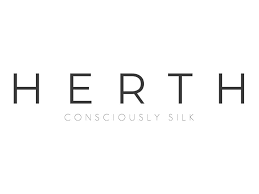
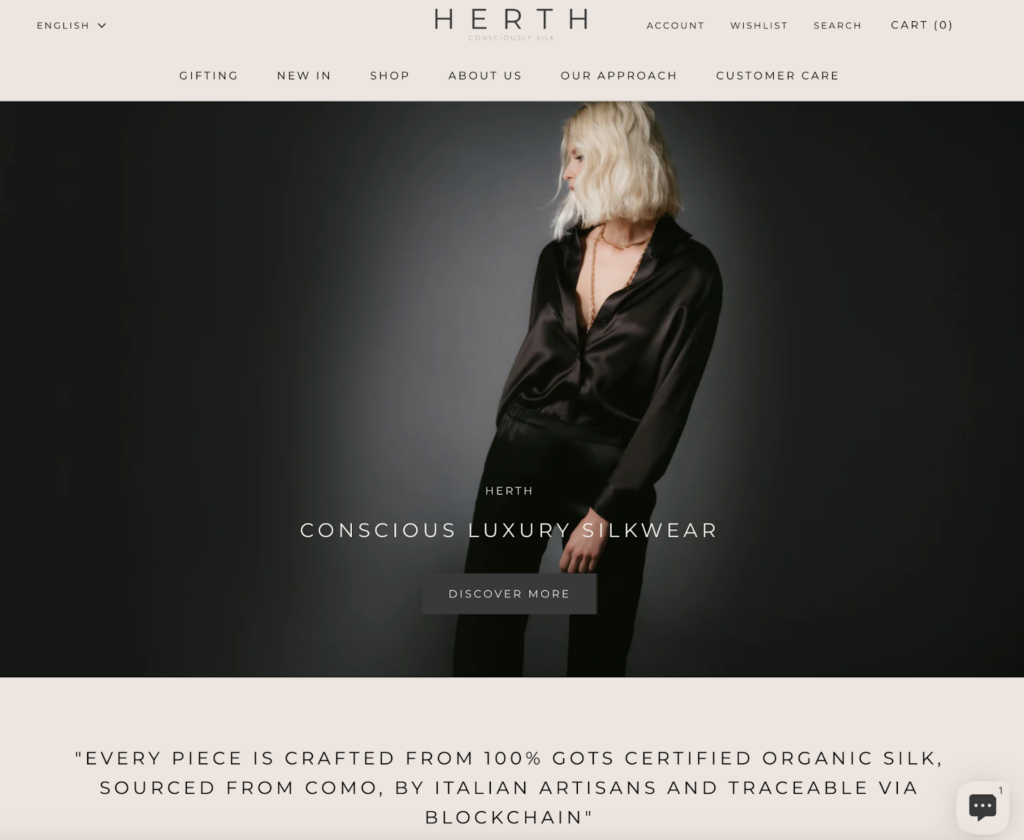
“Sustainability is at the center of everything we do. HERTH, from the design to the final product, from packaging to shipments, aims to be respectful to the environment and people, to inspire conscious buying habits.”
HERTH
🌎
How do they ensure their sustainability?
HERTH promotes sustainability by sourcing eco-friendly materials for their garments and packaging. They source exclusively carbon-neutral mulberry silk certified by the Global Organic Textile Standard (GOTS). The dyeing and printing processes that the silk is subject to are also GOTS-certified, meaning no harmful chemical substances are used during these manufacturing steps. They also use low-impact dyes in all their products. Regarding packaging, HERTH uses boxes made in Italy and tissue paper from recycled and responsibly sourced FSC-certified materials. Their cardboard tags are FSC-certified, uncoated, and 100% recycled, while their polyester labels are made with 100% recycled content, certified by the Global Recycle Standard. Their entire supply chain, from material sourcing to garment handcrafting, happens in Italy, with relatively short transportation distances, reducing carbon emissions. Once finished, their products are shipped using carbon-neutral services, meaning that the transport-related carbon emissions are offset through external climate protection projects.
🌐
How do they ensure their ethics?
HERTH ensures their ethics by making sure their whole supply chain is traceable. The blockchain technology in the QR codes found on their labels and tags enables consumers to see a full list of their suppliers, their certifications, their silk fabrics, and their production. Every person involved in their production process is assured a fair living wage and comfortable working conditions. Additionally, they use GOTS-certified silk, safeguarding the environment and its animals. The silkworms used for their silk are fed organic mulberry leaves and grown biodynamically without synthetic agrochemicals. They are allowed to fully develop and continue their life after leaving the cocoon, unlike the cruel practice in conventional silk manufacturing involving cocoons being boiled to prevent the moths from breaking the silk filament as they emerge.
🤝
Are they part of any giving-back programs?
HERTH partners with 1% for the Planet to donate 1% of their total annual sales to, as the name suggests, support the planet.
🛍️
What is their product range?
- Best for: womenswear
- Product range: bras, T-shirts, tops, shirts, pants, dresses, bodysuits, underwear, accessories
- Price range: $$$
- Size range: XS–XXL
Luva Huva: Beautiful Lingerie Designed And Made in the UK
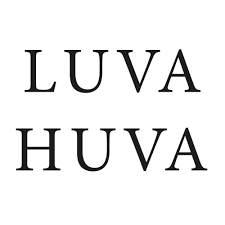
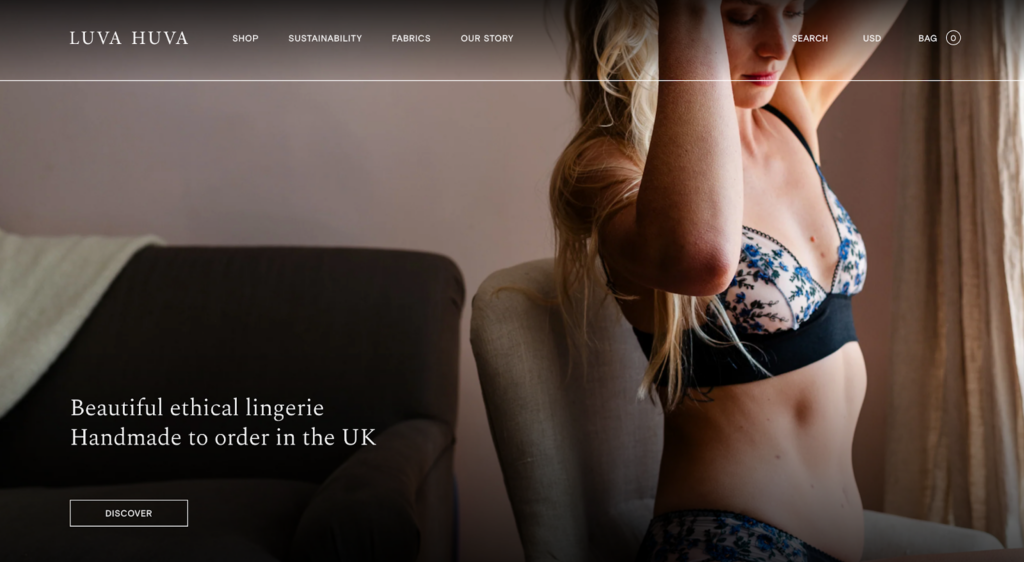
“Our fabrics are sustainable, recycled or upcycled, minimising our impact and giving them a second lease of life.”
Luva Huva
🌎
How do they ensure their sustainability?
Luva Huva promotes sustainability by sourcing low-impact fabrics and packaging materials, minimizing waste, and reducing carbon emissions. Firstly, their fabrics are sustainable, recycled, or upcycled. These include GOTS-certified organic cotton, bamboo, recycled polyester, and deadstock fabrics. They also use SeaCell, a seaweed and wood pulp fabric with the EU Ecolabel and OEKO-TEX® STANDARD 100 certification. Furthermore, the brand uses strong, plastic-free, and recycled packaging, including recycled tissue paper and natural jute ribbon. Secondly, they operate on a made-to-order seasonless system. By creating thoughtful designs for all-day-all-night comfort and creating new collections only when existing ones sell out, Luva Huva avoids unnecessary textile waste in both manufacturing and usage stages. Lastly, Luva Huva limits energy consumption in their studio, where their lingerie is made, and powers their operation partly with their roof solar power.
🌐
How do they ensure their ethics?
Luva Huva holds the final manufacturing stage in-house in Brighton, England. They also trace part of their supply chain.
🤝
Are they part of any giving-back programs?
Luva Huva donates fabric ends to local schools for craft projects.
🛍️
What is their product range?
- Best for: womenswear
- Product range: lingerie, sleepwear
- Price range: $$$
- Size range: XXS–XXL
Proclaim: Eco-Friendly Skin Tone Lingerie Made in the US

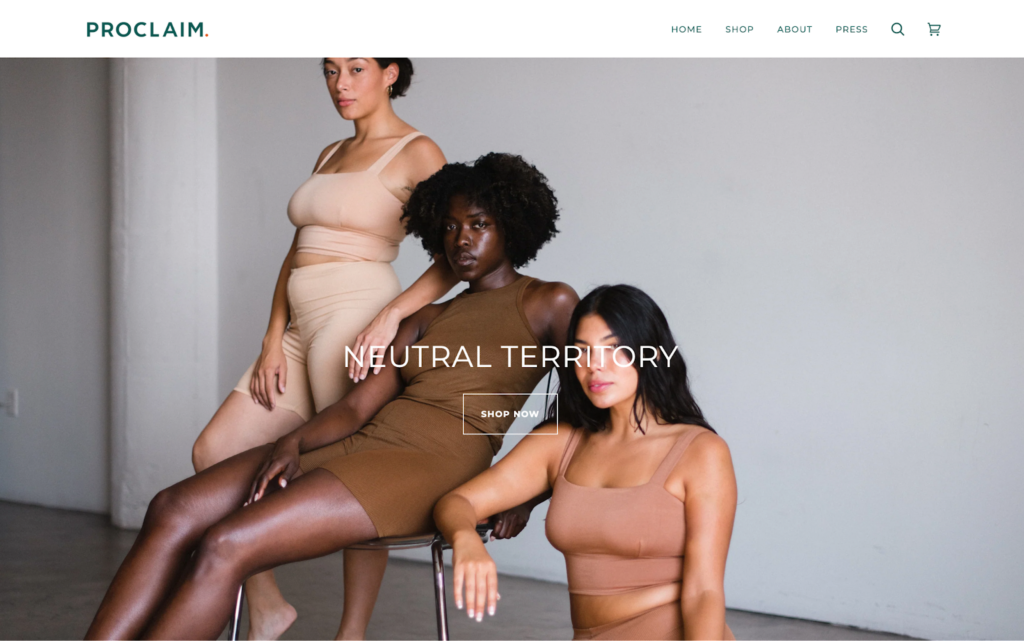
“We are founded on the principles that fashion should represent all women and can be made in a way that does good for people and the planet. Proclaim is expanding the definition of nude, one ethically made bra at a time.”
Proclaim
🌎
How do they ensure their sustainability?
Proclaim ensures sustainability by sourcing a high percentage of low-impact fabrics, reducing waste, and lowering carbon emissions. Firstly, they use four of the most sustainable fabrics: organic cotton, hemp, TENCEL™ Lyocell, and recycled polyester (REPREVE®). Secondly, they reduce waste by sourcing recycled materials (REPREVE® and Cupro), designing strategically to avoid fabric scraps during the cutting process, and repurposing scraps into new building materials. Last but not least, their supply chain is localized to a 30-mile radius to reduce transportation carbon emissions.
🌐
How do they ensure their ethics?
Proclaim makes their clothes in the US, a medium-risk country for labor abuse. They trace most of their supply chain, including all of the final and second stages of production. Their manufacturing partner is a family-run, BIPOC-owned apparel factory in LA that pays well above minimum wage.
🤝
Are they part of any giving-back programs?
During the COVID-19 pandemic, Proclaim created a “buy one, donate one” model of mask and donated masks, meals, and hygiene kits to the Downtown Women’s Center in LA.
🛍️
What is their product range?
- Best for: womenswear
- Product range: bras, panties, loungewear,
- Price range: $$$
Woron: Comfortable Lingerie and Socks Made Sustainably
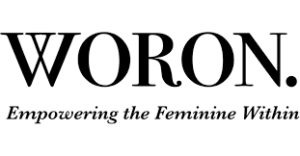
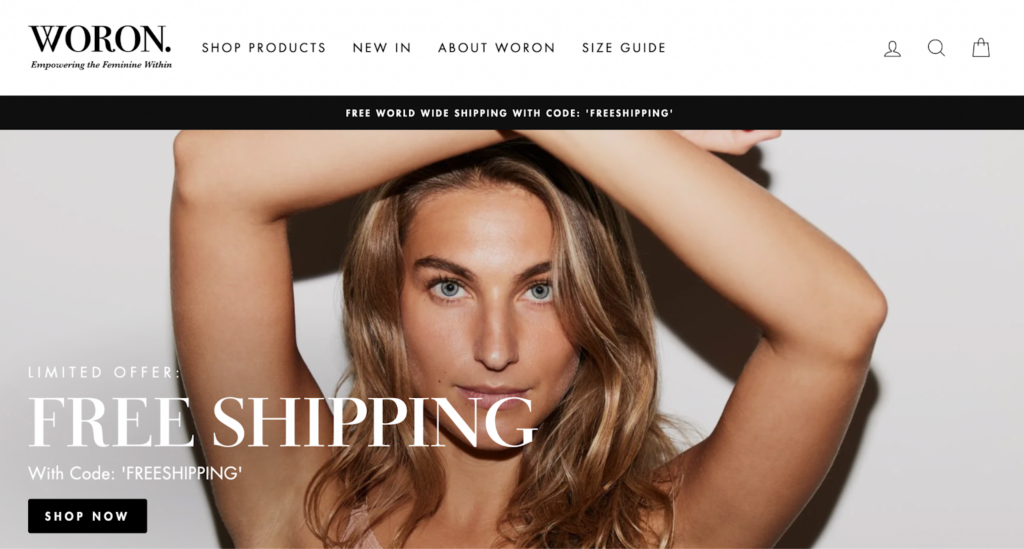
“At the core of everything we do at Woron is a strong respect for the people we work with and the environment we work within. We are well aware of the reputation of the fashion industry and strive to promote positive change.”
Woron
🌎
How do they ensure their sustainability?
Woron ensures sustainability by sourcing a medium proportion of eco-friendly materials for their bras, panties, and socks. They prioritize cellulose fibers derived from plants, including GOTS-certified organic cotton and beech-based modal by Lenzing. Also, they exclusively opt for recycled nylon, specifically ECONYL® fibers, for components like lace and mesh to reduce their environmental impacts. Furthermore, they don’t use any harmful chemicals and toxic dyes. Their bras are also free of metal pokes. Lastly, Woron operates on limited production runs to minimize textile waste.
🌐
How do they ensure their ethics?
Woron maintains ethics by disclosing their Europe-based manufacturing partners (located in Hungary, Greece, Italy, and Turkey). For example, their socks are made in a small family-owned business in Italy.
🤝
Are they part of any giving-back programs?
Woron is not known to be part of any giving-back programs.
🛍️
What is their product range?
- Best for: womenswear
- Product range: bras, underwear, loungewear, socks
- Price range: $$$
- Size range: XS–XL
Why Is It Important to Buy Products Made of More Sustainable Fabrics
It is important to buy products made from more sustainable fabrics because a sustainable textile industry has a lower carbon footprint, helps save natural resources, and is better for forests, animals, and humans alike.
Buying Sustainable Fabrics Reduces Your Carbon Footprint
The production of clothing and footwear is estimated to contribute 10% of global greenhouse gas emissions—more than all international flights and shipping combined. If the fashion industry were a country, it would be the fourth largest emitter of carbon dioxide.
One way to reduce the carbon footprint of the clothes you buy is to opt for sustainable fabrics. Sustainable fabrics, which are often made with natural or recycled fibers, have relatively low carbon footprints compared to petroleum-based fabrics. For example, organic cotton made in the US has a carbon footprint of 2.35 kg CO2 (per ton of spun fiber)—a quarter of polyester’s carbon footprint.
Buying Sustainable Fabrics Reduces Demand for Natural Resources and Waste Management
The textile industry uses water and land to grow cotton and other fibers. It is estimated that 79 billion cubic meters of water were used for the sector worldwide in 2015. For example, producing a single cotton T-shirt requires as much water as one person drinks for 2.5 years (2,700 liters of fresh water).
Worse yet, the textile economy is vastly more linear than circular: the largest amount of resources used in clothes ended up in landfills (instead of being recycled to remake clothes). According to a report by the Ellen MacArthur Foundation,
- Less than 3% of materials used in the textile economy in 2015 came from recycled sources.
- In other words, more than 97% of resources used in making clothes are newly extracted.
When clothing items are disposed of within a short period of time—under a year in the case of half of the fast fashion clothes—the natural systems that provide raw materials for fabrics don’t have enough time to recover and regenerate, which could lead to ecological breakdown.
Sustainable fabrics are made with less water and emissions while lasting longer:
- Because they are durable, you don’t need to buy new clothes too often.
- Thus, you help reduce the pressure to extract more resources for making new items.
Similarly, making and consuming sustainable fabrics made with recycled materials reduces the demand for virgin materials while helping tackle waste management.
Buying Sustainable Fabrics Encourages Sustainable Management of Forests
Sustainable plant-based fabrics are made with raw materials from forests and plantations that are sustainably managed, such as complying with FSC standards.
When you buy sustainable plant-based fabrics, you discourage unsustainable forestry practices like illegal logging. You can help reduce deforestation, biodiversity loss, and the effects of climate change.
Buying Sustainable Fabrics Encourages Fairer Treatment of Animals
The fashion industry is rife with animal mistreatment when it comes to making animal-based fabrics like wool or silk. Every year, billions of animals suffer and die for clothing and accessories.
Buying sustainable vegan alternatives can help to reduce the pressure on raising more and more animals to meet the demand for animal-based fabrics while sacrificing their well-being and lives.
Suppose you have to buy fabrics made with, for example, wool or silk; make sure you only choose brands committed to cruelty-free products. In that case, you help advocate better treatments for animals raised within the textile industry.
Using Sustainable Fabrics Encourages Fairer Treatment of Textile Workers
Recent statistics from UNICEF estimated as many as 170 million child laborers worldwide, many of whom were engaged in some form of work in the textile industry. They don’t get paid minimum wages and often work long hours.
When you buy sustainable fabrics from brands transparent about the working conditions at their factories, you discourage the use of child labor and help promote better working conditions for textile workers.
How Can You Generally Buy More Sustainable Fabrics
The key to sustainably buying fabrics is to check on relevant environmental and original certifications.
For natural fabrics:
- Global Organic Textile Standard (GOTS): A globally recognized certification system that ensures a certain threshold of organic content has been met. It covers manufacturing, packaging, labeling, transportation, and distribution (but not what happens in the fields where crops are grown).
- USDA Certified Biobased Product: The USDA BioPreferred® Certification is a voluntary certification offered by the United States Department of Agriculture. The certification identifies products made from plants or other renewable materials.
- Ecolabel: Ecolabel is the official European Union voluntary label recognized worldwide for certified products with a guaranteed, independently verified low environmental impact. The label requires high environmental standards throughout the entire life-cycle: from raw material extraction through production and distribution to disposal. It also encourages companies to develop innovative, durable, easy-to-repair, and recyclable products.
For plant-based semi-natural/semi-synthetic fabrics:
- Forest Stewardship Council: An FSC certification ensures that the wood (or wood-like material) comes from responsibly managed forests that provide environmental, social, and economic benefits.
There are two types of FSC Certification:- FSC Forest Management Certification, with a focus on the origin of the wood—the forest.
- FSC Chain of Custody Certification, which focuses on the path from the forest to the customer’s home.
- Program for Endorsement of Forest Certification: PEFC’s approaches to sustainable forest management are in line with protecting the forests globally and locally and making the certificate work for everyone. Getting a PEFC certification is strict enough to ensure the sustainable management of a forest is socially just, ecologically sound, and economically viable but attainable not only by big but small forest owners.
For recycled fabrics:
- Recycled Claim Standard (RCS): The Textile Exchange RCS was originally developed as an international, voluntary standard that sets requirements for third-party certification of Recycled input and chain of custody.
- The Global Recycled Standard (GRS): The Global Recycled Standard (GRS) is an international, voluntary, full product standard that sets requirements for third-party certification of Recycled Content, chain of custody, social and environmental practices, and chemical restrictions. It can be used for any product with more than 20% recycled material.
For all types of fabrics:
- STeP by OEKO-TEX®: STeP by OEKO-TEX® is an independent certification system for brands, retailers, and manufacturers from the textile and leather industry. It communicates organizational environmental measures, including reducing carbon footprint and water usage.
- OEKO-TEX® Standard 100: OEKO-TEX® labels aim to ensure that products pose no risk to human health (i.e. containing banned chemicals).
Some certifications that are signaling brands’ efforts toward lowered environmental impacts and a circular economy are:
- B Corp Certification: The label B Corp is a certification reserved for for-profit companies. Certified holders are assessed on their social and environmental impacts.
- Cradle2Cradle certification: Cradle2Cradle provides a standardized approach to material circularity. It assesses whether products have been suitably designed and made with the circular economy in mind covering five critical categories: material health, material reuse, renewable energy and carbon management, water stewardship, and social fairness.
Final Thoughts
Lingerie is a category of clothing that is often high-impact due to the materials conventionally used for elasticity and support. Thus, it is important to shop with ethics and sustainability in mind when choosing your lingerie sets.
By purchasing lingerie from brands that commit to sustainability, you support their mission to create a fairer and less harmful textile industry for all lives on Earth.
Here is the list (again) of the most sustainable lingerie brands:
- Subset
- Underprotection
- The Very Good Bra
- ColieCo
- Anekdot
- Araks
- HERTH
- Luva Huva
- Proclaim
- Woron
To make your use of these clothing items even more sustainable, follow these steps:
- Keep your lingerie for as long as possible.
- At the end-of-life of your lingerie pieces, upcycle the materials to extend their usage and arrange for them to be recycled or properly disposed of.
Sources
- Science Direct: Life-cycle assessment (LCA)
- Subset: Home
- Underprotection: Home
- The Very Good Bra: Home
- ColieCo: Home
- Anekdot: Home
- Araks: Home
- HERTH: Home
- Luva Huva: Home
- Woron: Home
- Eco Intimates: Home
- Subset: Becoming Carbon Neutral
- Good On You: Brand Directory | Subset
- Subset: SUBSET x Supercircle | Recycle your rejects
- Global Organic Textile Standard: Home
- Impactful Ninja: How Sustainable Are Organic Cotton Fabrics? A Life-Cycle Analysis
- Impactful Ninja: How Sustainable Are TENCEL Fabrics? A Life-Cycle Analysis
- Impactful Ninja: How Sustainable Are Recycled Polyester Fabrics? A Life-Cycle Analysis
- Impactful Ninja: How Sustainable Are Recycled Nylon Fabrics? A Life-Cycle Analysis
- Subset: Tank Bralette
- Subset: Our Materials
- Subset: 2022 Impact Report
- Subset: Organic Cotton Supply Chain
- Fairtrade: Fairtrade Standard for Small-Scale Producer Organisations
- I Support the Girls: Home
- Cultivate Initiatives: Home
- Underprotection: Lingerie
- B Corporation: Underprotection
- Good On You: Brand Directory | Underprotection
- Impactful Ninja: How Sustainable Are Lyocell Fabrics? A Life-Cycle Analysis
- Impactful Ninja: How Sustainable Are Recycled Wool Fabrics? A Life-Cycle Analysis
- Textile Exchange: Responsible Wool Standard
- Impactful Ninja: How Sustainable Are Sheep Wool Fabrics? A Life-Cycle Analysis
- Impactful Ninja: How Sustainable Are Synthetic Fabrics? A Life-Cycle Analysis
- Underprotection: Materials
- Textile Exchange: Global Recycle Standard
- Impactful Ninja: How Sustainable Are Polyester Fabrics? A Life-Cycle Analysis
- Impactful Ninja: How Sustainable Are Nylon Fabrics? A Life-Cycle Analysis
- Impactful Ninja: How Sustainable Are Spandex Fabrics? A Life-Cycle Analysis
- Impactful Ninja: How Sustainable Are Elastane Fabrics? A Life-Cycle Analysis
- Underprotection: Packaging
- Underprotection: Repair and Rewards
- Underprotection: Wash & Care
- Underprotection: Take-back program
- Underprotection: Upcycled
- Underprotection: I Tråd Med Verden
- Underprotection: Sustainable Report 2020
- Underprotection: Production
- Underprotection: Code of Conduct
- International Labour Organization: Fundamental Principles and Rights at Work
- Worldwide Responsible Accredited Production (WRAP): Home
- Sedex: Home
- Amfori: BSCI
- Underprotection: Green Friends
- Underprotection: TREEAPP
- Underprotection: ReSea
- The Very Good Bra: Bras
- The Very Good Bra: Briefs
- B Corporation: The Very Good Bra
- The Very Good Bra: Our Story
- The Very Good Bra: V for Victory Bra
- The Very Good Bra: How we work
- The Very Good Bra: Our Responsible Business Practices
- The Very Good Bra: Replacement straps
- Good On You: Brand Directory | The Very Good Bra
- The Very Good Bra: Factory Code of Conduct
- i=Change: Home
- The Social Outfit: Home
- Whitehouse Design: Home
- Thread Together: Home
- ColieCo: All about sustainability
- ColieCo: About our fabrics
- Impactful Ninja: How Sustainable Are Natural Fabrics? A Life-Cycle Analysis
- Impactful Ninja: How Sustainable Are Recycled Fabrics? A Life-Cycle Analysis
- OEKO-TEX: OEKO-TEX STANDARD 100
- Textile Exchange: Global Recycled Standard
- Impactful Ninja: How Sustainable Are Nylon Fabrics? A Life-Cycle Analysis
- Impactful Ninja: How Sustainable Are Elastane Fabrics? A Life-Cycle Analysis
- Impactful Ninja: How Sustainable Are TENCELTM Fabrics? A Life-Cycle Analysis
- ColieCo: Returns Policy
- Good On You: Brand Directory | ColieCo
- ColieCo: Ethical Production
- ColieCo: Code of Ethics and Conduct
- Impactful Ninja: How Sustainable Are Lycra® Fabrics? A Life-Cycle Analysis
- International Labour Organization: Fundamental Principles and Rights at Work
- Anekdot: About Us
- Anekdot: Full Moon Longline Bralette
- Good On You: Brand Directory | Anekdot
- S27: Home
- Drip By Drip: Home
- Araks: Lingerie
- Araks: Sustainability
- Good On You: Brand Directory | Araks
- Impactful Ninja: How Sustainable Are Organic Linen Fabrics? A Life-Cycle Analysis
- ECONYL: Home
- Tencel: REFIBRA™
- Araks: Materials
- Araks: Manufacturing
- Araks: Garment care
- HERTH: GOTS CERTIFIED ORGANIC SILK BRALETTES AND BRAS TOP
- HERTH: OUR GOTS CERTIFIED ORGANIC SILK AND THE NATURAL BENEFITS OF WEARING SILK
- Good On You: Brand Directory | HERTH
- HERTH: SUSTAINABILITY
- Textile Exchange: The RCS and GRS are designed to boost the use of recycled materials.
- HERTH: HOW WE USE BLOCKCHAIN TO TRACE THE SUPPLY CHAIN
- HERTH: CONTEMPORARY ITALIAN CRAFTSMANSHIP AND MADE IN ITALY
- Good On You: Brand Directory | Luva Huva
- Luva Huva: Sustainability
- Luva Huva: Fabrics
- Impactful Ninja: How Sustainable Are Organic Cotton Fabrics? A Life-Cycle Analysis
- Impactful Ninja: How Sustainable Are Bamboo Fabrics? A Life-Cycle Analysis
- Impactful Ninja: How Sustainable Are Recycled Polyester Fabrics? A Life-Cycle Analysis
- EU Ecolabel: Home
- OEKO-TEX: OEKO-TEX STANDARD 100
- Good On You: Brand Directory | Proclaim
- Impactful Ninja: 20 Most Sustainable Fabrics: The Full Life-Cycle Analysis
- REPREVE: Home
- Impactful Ninja: How Sustainable Are Cupro Fabrics? A Life-Cycle Analysis
- Proclaim: WHO WE ARE
- Ethical Style Journal: Brand Spotlight: Proclaim
- Good On You: Brand Directory | Woron
- Impactful Ninja: How Sustainable Are Modal Fabrics? A Life-Cycle Analysis
- Lenzing: Home
- Impactful Ninja: How Sustainable Are Econyl Fabrics? A Life-Cycle Analysis
- Woron: About Woron
- European Parliament: The impact of textile production and waste on the environment (infographic)
- Science Direct: The challenge of “Depeche Mode” in the fashion industry – Does the industry have the capacity to become sustainable through circular economic principles, a scoping review
- Science Direct: Carbon Footprint of Textile and Clothing Products
- European Parliament: Environmental impact of the textile and clothing industry
- European Parliament: What if fashion were good for the planet?
- Ellen MacArthur Foundation: A New Textiles Economy: Redesigning fashion’s future
- McKinsey: Style that’s sustainable: A new fast-fashion formula
- Forest Stewardship Council: Home
- Our World in Data: Deforestation and Forest Loss
- Our World in Data: Renewable Energy
- Peta: Animals Used For Clothing
- The Guardian: Child labour in the fashion supply chain
- Impactful Ninja: How Sustainable Are Natural Fabrics? A Life-Cycle Analysis
- Global Organic Textile Standard (GOTS): Home
- BioPreferred: WHAT IS THE BIOPREFERRED PROGRAM?
- European Commission: Environment | EU Ecolabel
- Impactful Ninja: How Sustainable Are Semi-Natural/Semi-Synthetic Fabrics? A Life-Cycle Analysis
- Forest Stewardship Council
- FSC Forest Management Certification
- FSC Chain of Custody Certification
- Textile Exchange: The RCS and GRS are designed to boost the use of recycled materials
- Program for Endorsement of Forest Certification
- Impactful Ninja: How Sustainable Are Recycled Fabrics? A Life-Cycle Analysis
- Textile Exchange: Recycled Claim Standard
- Textile Exchange: Global Recycled Standard
- OEKO-TEX: Certification according to STeP by OEKO-TEX®
- OEKO-TEX: OEKO-TEX® Standard 100
- B Corp Certification: Home
- C2CCertified: Home
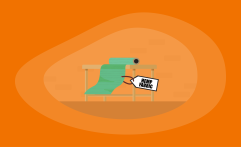
 ® Fabrics? A Life-Cycle Analysis" itemprop="image" class="left" />
® Fabrics? A Life-Cycle Analysis" itemprop="image" class="left" />


